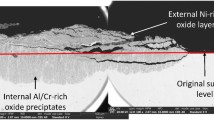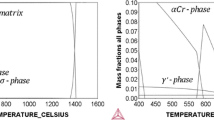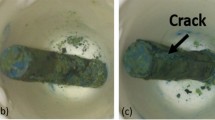Abstract
The goal of this research project was to provide a fundamental understanding of CaO-and CaSO4-induced corrosion in second-generation Ni-based single-crystal superalloys and to develop a lab-scale test procedure, which accurately replicates corrosion observed in field-exposed components. Secondary and transmission electron microanalyses were used to characterize the corrosion of field-exposed components taken from commercial aviation turbines. It was found that the field-exposed components had been attacked by internal oxidation-sulfidation. Isothermal laboratory-scale experiments at 900 and 1150 °C in air were conducted on superalloy coupons deposited with either CaO or CaSO4 to assess the extents and modes of solid-state corrosion caused by either deposit. A novel bi-thermal test procedure was then developed which effectively replicated the internal oxidation-sulfidation found in the field-exposed components. It was determined that compositional and microstructural changes to the alloy subsurface caused by CaSO4-induced corrosion at elevated temperatures made the alloy susceptible to internal oxidation at lower temperatures.





















Similar content being viewed by others
References
B. A. Pint, High-temperature corrosion in fossil fuel power generation: present and future. JOM 65, 1024 (2013).
D. A. Shifler“The Increasing Complexity of Hot Corrosion,” Journal of Engineering Gas Turbines Power, (2017).
R. A. Rapp, Hot corrosion of materials: a fluxing mechanism? Corrosion science 44, 209 (2002).
G. H. Meier, Current Aspects of Deposit-Induced Corrosion, (Springer, USA, 2021).
F. Pettit, Hot corrosion of metals and alloys. Oxidation of Metals 76, 1 (2011).
M. B. Krisak, B. I. Bentley, A. W. Phelps, and T. C. Radsick, Review of calcium sulfate as an alternative cause of hot corrosion. Journal of Propulsion and Power 33, 697 (2017).
T. J. Nijdam and R. van Gestel, Service experience with single crystal superalloys for high pressure turbine shrouds, Natl. Lucht- en Ruimtevaartlaboratorium. NLR-TP-2011–547, (2010).
J. Stringer and A. J. Minchener, High temperature corrosion in fluidized bed combustion systems. Journal of materials for energy systems 7, 333 (1986).
J. Stringer and I. G. Wright, Materials issues in fluidized bed combustion. Journal of materials for energy systems 8, 319 (1986).
K. T. Chiang, G. H. Meier, and R. A. Perkins, The effects of deposits of CaO, CaSO4, and MgO on the oxidation of several Cr2O3-forming and Al2O3-forming alloys. Journal of materials for energy systems 6, 71 (1984).
K. Jung, “Solid Deposit-Induced High Temperature Oxidation,” University of Pittsburgh, 2008.
T. Gheno, G. H. Meier, and B. Gleeson, High temperature reaction of MCrAlY coating compositions with CaO deposits. Oxidation of Metals 84, 185–209 (2015).
I. Barin, Thermochemical Data of Pure Substances, 3rd ed. Wiley, 2008.
A. Durga, H. Dai, S. Huang, I. Spinelli, and L. Yuan, Grain structure prediction for directionally solidified superalloy castings. JOM 72, 1785–1793 (2020).
C. F. Beaton, Heat Exchanger Design Handbook. Hemisphere Publishing Corp, 1986.
C. S. Giggins and F. Pettit, Oxidation of Ni-Cr-Al alloys between 1000 and 1200° C. Journal of the Electrochemical Society 118, 1782 (1971).
K. Y. Jung, F. S. Pettit, and G. H. Meier, The effect of Ca-rich deposits on the high temperature degradation of coated and uncoated superalloys. Materials Science Forum. 595, 805 (2008).
W. M. Swift, A. F. Panek, G. W. Smith, G. J. Vogel, and A. A. Janke, “Decomposition of Calcium Sulfate: a Review of the Literature.” pp. 1–64, 1976.
I. Colussi and V. Longo, La decomposizione termica del solfato di calcio. Il Cemento 2, 75 (1974).
B. M. Mohamed and J. H. Sharp, Kinetics and mechanism of formation of monocalcium aluminate, CaAl2O4. Journal of Materials Chemistry 7, 1595 (1997).
C. Wagner, Reaktionstypen bei der Oxydation von Legierungen. Zeitschrift für Elektrochemie, Berichte der Bunsengesellschaft für physikalische Chemie 63, 772 (1959).
N. Birks, G. H. Meier, and F. S. Pettit, Introduction To The High Temperature Oxidation of Metals, 2nd ed. Cambridge University Press, 2006.
J. W. Park and C. J. Altstetter, The diffusion and solubility of oxygen in solid nickel. Metallurgical Transactions A 18, 43 (1987).
M. S. A. Karunaratne, P. Carter, and R. C. Reed, On the diffusion of aluminium and titanium in the Ni-rich Ni–Al–Ti system between 900 and 1200 C. Acta materialia 49, 861 (2001).
W. Zhao and B. Gleeson, Assessment of the detrimental effects of Steam on Al2O3-scale establishment. Oxidation of Metals 83, 607 (2015).
P. T. Brennan, “Environmental Factors Affecting CaO and CaSO4-Induced Degradation of Second-Generation Nickel-Based Superalloys,” University of Pittsburgh, 2020.
J. A. Goebel and F. S. Pettit, The influence of sulfides on the oxidation behavior of nickel-base alloys. Metallurgical Transactions 1, 3421 (1970).
B. Schramm and W. Auer, Sulfidation behaviour of nickel aluminides. Material Corrossion 47, 678 (1996).
C. J. Spengler and R. Viswanathan, Effect of sequential sulfidation and oxidation on the propagation of sulfur in an 85 Ni-15 Cr alloy. Metallurgical and Materials Transactions B 3, 161 (1972).
J. L. Meijering, Advances in Materials Science. Wiley, 1971.
Funding
Funding support of this study by the Office of Naval Research (grant N00014-17–1-2916), Dr. David Shifler. Program Manager, is greatly appreciated.
Author information
Authors and Affiliations
Corresponding author
Additional information
Publisher's Note
Springer Nature remains neutral with regard to jurisdictional claims in published maps and institutional affiliations.
Rights and permissions
About this article
Cite this article
Brennan, P.T., Konitzer, D., Brennan, M. et al. Solid-State Deposit-Induced Corrosion of a Second-Generation Nickel-Based Superalloy Caused by CaO and CaSO4 Deposits. Oxid Met 98, 43–63 (2022). https://doi.org/10.1007/s11085-022-10105-7
Received:
Revised:
Accepted:
Published:
Issue Date:
DOI: https://doi.org/10.1007/s11085-022-10105-7




